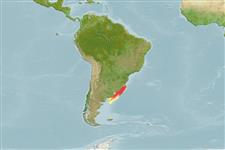Common names from other countries
Teleostei (teleosts) >
Eupercaria/misc (Various families in series Eupercaria) >
Sciaenidae (Drums or croakers)
Etymology: Umbrina: Latin, umbra, -ae = shadow, in the sense of phantom; due to its quick movements (Ref. 45335).
Environment: milieu / climate zone / depth range / distribution range
Ecology
Marine; brackish; demersal; oceanodromous (Ref. 51243); depth range ? - 200 m (Ref. 47377), usually 10 - 100 m (Ref. 27363). Subtropical; 31°S - 42°S, 62°W - 49°W (Ref. 54933)
Southwest Atlantic: Cabo de São Tomé, Rio de Janeiro, Brazil to Bonaerensis, Argentina.
Length at first maturity / Size / Weight / Age
Maturity: Lm 15.9, range 17 - ? cm
Max length : 53.3 cm TL male/unsexed; (Ref. 39376); common length : 37.0 cm TL male/unsexed; (Ref. 7025); max. reported age: 26 years (Ref. 7025)
Short description
Morphology | Morphometrics
Especially abundant at about 100 m depth (Ref. 27363). Found over sand and mud bottoms (Ref. 47377).
Life cycle and mating behavior
Maturity | Reproduction | Spawning | Eggs | Fecundity | Larvae
Haimovici, M., 1988. Cohort analysis on the Argentine croaker (Umbrina canosai) exploited in South Brazil, Uruguay and Argentina. Publ. Com. Tec. Mixta Frente Marit. Argent. Urug. 4:33-40. (Ref. 7415)
IUCN Red List Status (Ref. 130435)
CITES (Ref. 128078)
Not Evaluated
Threat to humans
Harmless
Human uses
Fisheries: highly commercial
More information
ReferencesAquacultureAquaculture profileStrainsGeneticsElectrophoresesHeritabilityDiseasesProcessingMass conversion
Tools
Special reports
Download XML
Internet sources
Estimates based on models
Preferred temperature (Ref.
115969): 8 - 19.8, mean 14.8 (based on 242 cells).
Phylogenetic diversity index (Ref.
82804): PD
50 = 0.5000 [Uniqueness, from 0.5 = low to 2.0 = high].
Bayesian length-weight: a=0.00891 (0.00728 - 0.01090), b=3.08 (3.06 - 3.10), in cm Total Length, based on LWR estimates for this species (Ref.
93245).
Trophic level (Ref.
69278): 3.9 ±0.57 se; based on food items.
Resilience (Ref.
120179): Medium, minimum population doubling time 1.4 - 4.4 years (K=0.26-0.27).
Fishing Vulnerability (Ref.
59153): Low to moderate vulnerability (32 of 100).
Climate Vulnerability (Ref.
125649): Moderate to high vulnerability (49 of 100).
